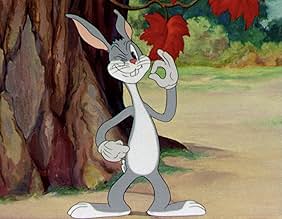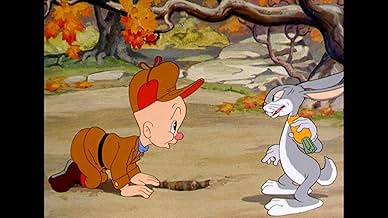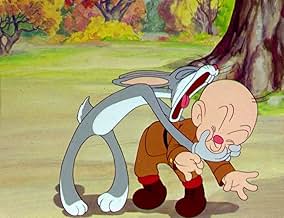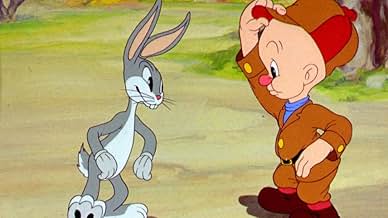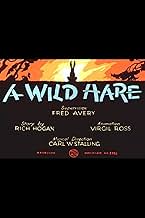IMDb RATING
7.7/10
2.1K
YOUR RATING
While hunting rabbits, Elmer Fudd comes across Bugs Bunny, who tricks and harasses the hunter.While hunting rabbits, Elmer Fudd comes across Bugs Bunny, who tricks and harasses the hunter.While hunting rabbits, Elmer Fudd comes across Bugs Bunny, who tricks and harasses the hunter.
- Director
- Writer
- Stars
- Nominated for 1 Oscar
- 2 nominations total
Mel Blanc
- Bugs Bunny
- (voice)
- (uncredited)
- …
Arthur Q. Bryan
- Elmer Fudd
- (voice)
- (uncredited)
- Director
- Writer
- All cast & crew
- Production, box office & more at IMDbPro
Featured reviews
Elmer and Bugs finally collide for real this time for the first time ever, in an excellent short by the late, great Tex Avery that hints of things to come. Elmer of course is hunting rabbits, Bugs(unnamed when this came out, although we all know it's him now) is of course defending himself, foiling Elmer's plans and driving him crazy. This is one of the two's best(why wasn't this on the Looney Tunes DVD? Oh well, guess I can wait for a Silver collection). I recommend seeing it to any fan of the "wabbit," or the hunter. After seeing how little has actually changed between the two, it's easy to realize that some things really do never change.
BOTTOM LINE: The first, and one of the best, Bugs vs. Elmer shorts.
BOTTOM LINE: The first, and one of the best, Bugs vs. Elmer shorts.
It is very hard to review "A Wild Hare" on its own solo merit after the sixty-plus years that followed and thus turned its central character into the biggest cartoon character ever. In comparison to the subsequent films that appeared until 1964, this very first official entry is tame but still a wonderful model for those that followed.
Let's say this was 1940 and If I saw this cartoon for the first time ever with absolutely no knowledge of Bugs Bunny, I would say that "A Wild Hare" alone is a fine cartoon, in which the hunter becomes the heckled. The prey is a slick "wabbit" character that starts in on him at the very beginning, knocking on the wisping hunter's bald head to get his attention.
It is no wonder that this cartoon is directed by Fred Avery, who only three years ago directed a similar cartoon called "Porky's Duck Hunt," in which Porky's prey evolved into the current Looney Tunes star Daffy Duck. Should we be keeping our eyes on this "wabbit?"
Let's say this was 1940 and If I saw this cartoon for the first time ever with absolutely no knowledge of Bugs Bunny, I would say that "A Wild Hare" alone is a fine cartoon, in which the hunter becomes the heckled. The prey is a slick "wabbit" character that starts in on him at the very beginning, knocking on the wisping hunter's bald head to get his attention.
It is no wonder that this cartoon is directed by Fred Avery, who only three years ago directed a similar cartoon called "Porky's Duck Hunt," in which Porky's prey evolved into the current Looney Tunes star Daffy Duck. Should we be keeping our eyes on this "wabbit?"
Rabbits were common in early animation such as in Walt Disney's 'Oswald the Rabbit.' But the king of all cartoon rabbits is Bugs Bunny. His first official appearance was in July 1940 "A Wild Hare,' co-starring Elmer Fudd as the hunter entrapped by Bugs Bunny's clever antics.
The Merrie Melody cartoon, drawn by the wizard artists at Leon Schlesinger Productions, was part of Warner Brothers distribution arm. The studio had introduced an earlier incarnation of Bugs in 1938's "Porky's Hare Hunt' featuring a frustrated Porky the Pig trying to shoot a clever and elusive rabbit. Four cartoons later of the pesky rabbit Bugs appeared in "A Wild Hare," directed by Tex Avery. Voice actor Mel Blanc employed his Bronx/Brooklyn accent to mimic the rabbit modern viewers are familiar. This is the first cartoon Bugs uses his catchphrase, "What's up, Doc?" Director Tex Avery claims he's the one who came up with the phrase from his days living in Texas where it was a commonly said. Mel Blanc, however, said he first ad-libbed the saying spontaneously in the narration booth, and everyone loved it.
Animator Bob Givens was assigned to redesign the previous rabbits into the basic look we see today as Bugs Bunny. Givens lengthened the rabbit's body, and has him standing straight up. There were a couple of attributes as to the origins on Bugs' habit chomping on carrots. One is the famous scene in 1934's Academy Award Best Picture winner "It Happened One Night" where Clark Gable munches on a carrot while Claudette Colbert exhibits her method of hitchhiking. Another is wise-cracking actor Roscoe Karns' character Oscar Shapely in the same movie, who was a big carrot fan.
Bugs Bunny appeared in over 160 cartoons between 1940 and 1964, and has been in more films than any other animated character. Bugs has a star on Hollywood's Walk of Fame and is Warner Brothers' official mascot.
The Merrie Melody cartoon, drawn by the wizard artists at Leon Schlesinger Productions, was part of Warner Brothers distribution arm. The studio had introduced an earlier incarnation of Bugs in 1938's "Porky's Hare Hunt' featuring a frustrated Porky the Pig trying to shoot a clever and elusive rabbit. Four cartoons later of the pesky rabbit Bugs appeared in "A Wild Hare," directed by Tex Avery. Voice actor Mel Blanc employed his Bronx/Brooklyn accent to mimic the rabbit modern viewers are familiar. This is the first cartoon Bugs uses his catchphrase, "What's up, Doc?" Director Tex Avery claims he's the one who came up with the phrase from his days living in Texas where it was a commonly said. Mel Blanc, however, said he first ad-libbed the saying spontaneously in the narration booth, and everyone loved it.
Animator Bob Givens was assigned to redesign the previous rabbits into the basic look we see today as Bugs Bunny. Givens lengthened the rabbit's body, and has him standing straight up. There were a couple of attributes as to the origins on Bugs' habit chomping on carrots. One is the famous scene in 1934's Academy Award Best Picture winner "It Happened One Night" where Clark Gable munches on a carrot while Claudette Colbert exhibits her method of hitchhiking. Another is wise-cracking actor Roscoe Karns' character Oscar Shapely in the same movie, who was a big carrot fan.
Bugs Bunny appeared in over 160 cartoons between 1940 and 1964, and has been in more films than any other animated character. Bugs has a star on Hollywood's Walk of Fame and is Warner Brothers' official mascot.
A Wild Hare (1940)
*** 1/2 (out of 4)
This is where it all started as the dimwitted Elmer Fudd travels to the woods hunting rabbit and comes across Bugs Bunny who is just too smart. A WILD HARE was actually the third film that Bugs appeared in but this here is the official first as the rabbit we all love. It's funny watching this first short because what's here is what we'd see for the next several decades as Bugs was just so appealing and he was often put up against rather dumb characters. There are several very funny moments here but the highlight has to be poor Elmer not realizing that while his digging for the rabbit that he's actually sitting there talking to him. Another highlight is the scene where Bugs pretends to die just so he can pull one more prank.
*** 1/2 (out of 4)
This is where it all started as the dimwitted Elmer Fudd travels to the woods hunting rabbit and comes across Bugs Bunny who is just too smart. A WILD HARE was actually the third film that Bugs appeared in but this here is the official first as the rabbit we all love. It's funny watching this first short because what's here is what we'd see for the next several decades as Bugs was just so appealing and he was often put up against rather dumb characters. There are several very funny moments here but the highlight has to be poor Elmer not realizing that while his digging for the rabbit that he's actually sitting there talking to him. Another highlight is the scene where Bugs pretends to die just so he can pull one more prank.
This is my third favorite cartoon, only beat by Invasion of the Bunny Snatchers and Duck Amuck. It manages to feel newer than the shorts where Elmer is fat, due to having Elmer's final design. It also has value that makes this based, introducing Bugs.
Did you know
- TriviaThe producers' reaction to the gag of Bugs responding to a hunter pointing a gun at him with a confident casual remark, "What's up, Doc?" was so favorable that they decided to make that a standard element of future films featuring the character.
- GoofsAfter Bugs ties up Elmer's shotgun and Elmer throws it away he then starts digging. Bugs comes up from his other hole, saying his first time ever "Eh Whats up Doc?" then Elmer says "I am looking for a Wabbit". Bugs starts describing a rabbit and during a close up When Elmer realized Bugs is a rabbit he us holding the shotgun again, next panel it's gone again.
- Quotes
[first lines]
Elmer Fudd: [first occurence of this line] Be vewy, vewy qwiet. I'm hunting wabbits.
- Crazy creditsIn the 1944 Blue Ribbon reissue of this cartoon, when the WB shield zooms in the copyright notice briefly says MCMXLIV(1944) for a fraction of a second before changing to MCMXL(1940)!
- Alternate versionsWhen the cartoon was re-released as a Blue Ribbon re-issue, it was inadvertently retitled "The Wild Hare." Also, one of the names Elmer Fudd guesses was changed from Carole Lombard, who had recently died in a plane crash, to Barbara Stanwyck.
- ConnectionsEdited into Bugs Bunny Superstar (1975)
- SoundtracksYankee Doodle
(ca. 1755) (uncredited)
Traditional music of English origin
Details
- Release date
- Country of origin
- Official site
- Language
- Also known as
- A Wild Hare
- Production company
- See more company credits at IMDbPro
- Runtime
- 8m
- Sound mix
- Aspect ratio
- 1.37 : 1
Contribute to this page
Suggest an edit or add missing content

